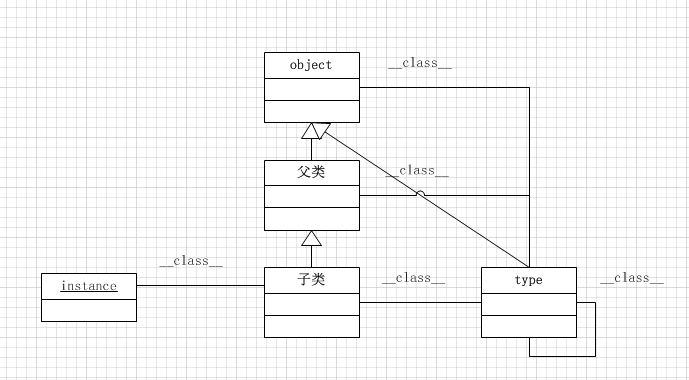温馨提示:这篇文章已超过377天没有更新,请注意相关的内容是否还可用!
背景
PHP的$和->让人输入的手疼(PHP确实非常简洁和强大,适合WEB编程),Ruby的#、@、@@也好不到哪里(OO人员最该学习的一门语言)。
Python应该是写起来最舒服的动态语言了,一下是一些读书笔记,最后会介绍一下高级的用法:Mixin、Open Class、Meta Programming和AOP。
文中有些地方是用2.7开发的,如果您安装的是3.x,有几点需要注意:
print "xxx" 要换成 print("xxx")
__metaclass__ = type 删除掉。
类型和表达式部分
你好,世界!
1 # coding=utf-82 3 print "你好,世界。"
乘方
1 print 2**10
变量
1 var = 12 print var3 4 var = "段光伟"5 print var
注:这里的var = xxxx不叫变量赋值,而叫变量绑定,python维护了一个符号表(变量名)以及符合对应的值,这个对应关系就叫做绑定,一个符号可以绑定任意类型的值。
获取用户输入
1 #获取用户输入2 x = input("x:")3 y = input("y:")4 5 print x*y注:input接受的是Python代码,输入中可以访问当前执行环境中的变量,如果想获取原始输入需要使用 raw_input。
函数定义
1 def say_b():2 print "b"
强类型
Javascript和Php是弱类型的,Python和Ruby是强类型的。弱类型允许不安全的类型转换,强类型则不允许。
1 #1 + “1” 这行代码在Python中会报错。2 print 1 + int("1")3 print str(1) + "1"字符串
1 #字符串2 print '''' 段3 光4 伟'''5 print r'C:\log.txt'6 print 'C:\log.txt'
序列
这里先介绍三种序列:列表、元祖和字符串。
序列通用操作
1 seq = "0123456789" 2 print seq[0] #从0开始编码。 3 print seq[-1] #支持倒着数数,-1代表倒数第一。 4 print seq[1:5] #支持分片操作,seq[start:end],start会包含在结果中,end不会包含在结果中。 5 print seq[7:] #seq[start:end]中的end可以省略。 6 print seq[-3:] #分片也支持负数。 7 print seq[:3] #seq[start:end]中的start也可以省略。 8 print seq[:] #全部省略会复制整个序列。 9 print seq[::2] #支持步长。10 print seq[::-2] #支持负步长。11 print seq[9:1:-1] #支持负步长。12 print [1, 2, 3] + [4, 5, 6] # 序列支持相加,这解释了为啥字符串可以相加。13 print [1, 2, 3] * 3 #序列支持相乘,这解释了为啥字符串可以相称。14 print [None] * 10 #生成一个空序列。15 print 1 in [1, 2, 3] #成员判断。
可变的列表
1 data = [0, 1, 2, 3, 4, 5, 6, 7, 8, 9, 10]; 2 3 data[0] = "a" #修改元素。 4 print data 5 data[0] = 0 6 7 del data[10] #删除元素。 8 print data 9 10 del data[8:] #分片删除。11 print data12 13 data[8:] = [8, 9, 10] #分片赋值14 print data
不可变的元祖
1 print (1, 2) #元祖以小括号形式声明。2 print (1,) #一个元素的元祖。
字符串格式化
1 print "% 10s" % "----"2 3 print '''4 %(title)s5 %(body)s6 ''' % {"title": "标题", "body": "内容"}字典
1 print {"title": "title", "body": "body"}2 print dict(title = "title", body = "body")3 print dict([("title", "title"), ("body", "body")])1 dic = {"title": "title", "body": "body"};2 print dic["title"]3 del dic["title"]4 print dicprint 语句
1 print 'a', 'b' #print可以接受多个参数,参数的输出之间以空格相隔。2 print 'a', #如果逗号之后没有参数,则不会换行。3 print 'b'
序列解包
1 x, y, z = 1, 2, 32 print x, y, z3 (x, y, z) = (1, 2, 3)4 print x, y, z5 (x, y, z) = [1, 2, 3]6 print x, y, z
bool值
1 #下面的输入全部返回False。 2 print(bool(None)) 3 print(bool(())) 4 print(bool([])) 5 print(bool({})) 6 print(bool("")) 7 print(bool(0)) 8 9 #虽然这些值在条件运算中会当做False,但是本身不等于False。10 print(True and "")11 print(not "")12 print(False == "")13 print(False == 0) #0除外,bool类型的内部表示就是int类型。bool运算
1 print(0 < 1 < 10)2 print(0 < 1 and 1 < 10)3 print(not(0 > 1 > 10))4 print(not(0 > 1 or 1 > 10))
语句块
:开始语句快,缩进的所有内容都是一个语句块。
1 if(10 > 1):2 print("10 > 1")3 else:4 print("不可能发生")三元运算符
1 print("10 > 1" if 10 > 1 else "不可能发生")相等比较
1 #== 和 is的差别,==比较的是内容,is比较的是引用。2 x = [1, 2, 3]3 y = x4 z = [1, 2, 3]5 print(x == y)6 print(x == z)7 print(x is y)8 print(x is z)
循环
1 #for循环类似C#的foreach,注意for后面是没有括号的,python真是能简洁就尽量简洁。 2 for x in range(1, 10): 3 print(x) 4 5 for key in {"x":"xxx"}: 6 print(key) 7 8 for key, value in {"x":"xxx"}.items(): 9 print(key, value)10 11 for x, y, z in [["a", 1, "A"],["b", 2, "B"]]:12 print(x, y, z) 1 #带索引的遍历 2 for index, value in enumerate(range(0, 10)): 3 print(index, value) 4 5 #好用的zip方法 6 for x, y in zip(range(1, 10), range(1, 10)): 7 print(x, y) 8 9 #循环中的的else子句10 from math import sqrt11 for item in range(99, 1, -1):12 root = sqrt(item)13 if(root == int(root)):14 print(item)15 break16 else:17 print("没有执行break语句。")pass、exec和eval
1 #pass、exec、eval2 if(1 == 1):3 pass4 5 exec('print(x)', {"x": "abc"})6 print(eval('x*2', {"x": 5}))函数部分
形参和实参之间是按值传递的,当然有些类型的值是引用(对象、列表和字典等)。
1 # 基本函数定义。 2 def func(): 3 print("func") 4 5 func() 6 7 # 带返回值的函数。 8 def func_with_return(): 9 return ("func_with_return")10 11 print(func_with_return())12 13 # 带多个返回值的函数。14 def func_with_muti_return():15 return ("func_with_muti_return", "func_with_muti_return")16 17 print(func_with_muti_return())18 19 # 位置参数20 def func_with_parameters(x, y):21 print(x, y)22 23 func_with_parameters(1, 2)24 25 # 收集多余的位置参数26 def func_with_collection_rest_parameters(x, y, *rest):27 print(x, y)28 print(rest)29 30 func_with_collection_rest_parameters(1, 2, 3, 4, 5)31 32 #命名参数33 def func_with_named_parameters(x, y, z):34 print(x, y, z)35 36 func_with_named_parameters(z = 1, y = 2, x = 3)37 38 #默认值参数39 def func_with_default_value_parameters(x, y, z = 3):40 print(x, y, z)41 42 func_with_default_value_parameters(y = 2, x = 1)43 44 #收集命名参数45 def func_with_collection_rest_naned_parameters(*args, **named_agrs):46 print(args)47 print(named_agrs)48 49 func_with_collection_rest_naned_parameters(1, 2, 3, x = 4, y = 5, z = 6)50 51 #集合扁平化52 func_with_collection_rest_naned_parameters([1, 2, 3], {"x": 4, "y": 4, "z": 6}) #这会导致args[0]指向第一个实参,args[1]指向第二个实参。53 func_with_collection_rest_naned_parameters(*[1, 2, 3], **{"x": 4, "y": 4, "z": 6}) #这里的执行相当于func_with_collection_rest_naned_parameters(1, 2, 3, x = 4, y = 5, z = 6)。作用域
1 # coding=utf-8 2 3 # 只有函数执行才会开启一个作用域。 4 if(2 > 1): 5 x = 1 6 7 print(x) # 会输出1。 8 9 10 # 使用vars()函数可以访问当前作用域包含的变量。11 x = 112 print(vars()["x"])13 14 # 使用globals()函数可以访问全局作用域。15 x = 116 17 def func():18 print(globals()["x"])19 20 func()21 22 # 使用locals()函数可以访问局部作用域。23 def func():24 x = 225 print(locals()["x"])26 27 func()28 29 # 每个函数定义时都会记住所在的作用域。30 # 函数执行的时候会开启一个新的作用域,函数内变量访问的规则是:先访问当前作用域,如果没有就访问函数定义时的作用域,递归直到全局作用域。31 x = 132 33 def func():34 y = 235 print(x, y) # 输出1 236 37 func()38 39 40 # 变量赋值始终访问的是当前作用域。41 x = 142 43 def func():44 x = 245 y = 246 print(x, y) # 输出2 247 48 func()49 print(x) #输出 150 51 # 局部变量会覆盖隐藏全局变量,想访问全局变量可以采用global关键字或globals()函数。52 x = 153 54 def func():55 global x56 x = 257 y = 258 print(x, y) # 输出2 259 60 func()61 print(x) #输出 2
1 # python支持闭包 2 def func(x): 3 def inner_func(y): 4 print(x + y) 5 6 return inner_func 7 8 inner_func = func(10) 9 inner_func(1)10 inner_func(2)
1 #函数作为对象2 def func(fn, arg):3 fn(arg)4 5 func(print, "hello")6 func(lambda arg : print(arg), "hello")
模块
几个模块相关的规则:
一个文件代表一个模块。
可以用import module导入模块,也可以用form module import member导入模块的成员。
如果导入的是module,必须使用module.member进行访问;如果导入的member,可以直接访问member。
导入的module或member都会变成当前module的member。
b.py
1 # coding=utf-82 3 print __name__4 5 def say_b():6 print "b"
a.py
1 # coding=utf-82 3 import b4 from b import *5 6 print __name__7 8 def say_a():9 print "a"
test.py
1 # coding=utf-82 3 import a4 5 print __name__6 7 a.say_a();8 a.say_b();9 a.b.say_b()
输出
1 b2 a3 __main__4 a5 b6 b
异常管理
1 # coding=utf-8 2 3 # 自定义异常 4 class HappyException(Exception): 5 pass 6 7 # 引发和捕获异常 8 try: 9 raise HappyException10 except:11 print("HappyException")12 13 try:14 raise HappyException()15 except:16 print("HappyException")17 18 # 捕获多种异常19 try:20 raise HappyException21 except (HappyException, TypeError):22 print("HappyException")23 24 # 重新引发异常25 try:26 try:27 raise HappyException28 except (HappyException, TypeError):29 raise30 except:31 print("HappyException")32 33 #访问异常实例34 try:35 raise HappyException("都是我的错")36 except (HappyException, TypeError), e:37 print(e)38 39 #按类型捕获40 try:41 raise HappyException42 except HappyException:43 print("HappyException")44 except TypeError:45 print("TypeError")46 47 #全面捕获48 try:49 raise HappyException50 except:51 print("HappyException")52 53 #没有异常的else54 try:55 pass56 except:57 print("HappyException")58 else:59 print("没有异常")60 61 #总会执行的final62 try:63 pass64 except:65 print("HappyException")66 else:67 print("没有异常")68 finally:69 print("总会执行")面向对象
先上一张图

几个规则:
一切都是对象,python中一切都是对象,每个对象都包含一个__class__属性以标记其所属类型。
每个对象(记得一切都是对象啊)都包含一个__dict__属性以存储所有属性和方法。
每个类型都包含一个__bases__属性以标记其父类。
属性和方法的访问规则:依次搜索instance、子类、父类、父类的父类、直到object的__dict__,如果找到就返回。
属性和方法的设置规则:直接设置instance.__dict__。
以上属性和方法访问或设置规则没有考虑“魔法方法”,下文会解释。
示例
1 # coding=utf-8 2 3 __metaclass__ = type 4 5 # 类型定义 6 # 实例方法必的第一个参数代表类型实例,类似其他语言的this。 7 class Animal: 8 name = "未知" # 属性定义。 9 10 def __init__(self, name): #构造方法定义。11 self.name = name12 13 def getName(self): # 实例方法定义。14 return self.name15 16 def setName(self, value):17 self.name = value18 19 print(Animal.name) # 未知20 print(Animal.__dict__["name"]) # 未知21 22 animal = Animal("狗狗")23 print(animal.name) # 狗狗24 print(animal.__dict__["name"]) # 狗狗25 print(Animal.name) # 未知26 print(Animal.__dict__["name"]) # 未知27 print(animal.__class__.name) # 未知28 print(animal.__class__.__dict__["name"]) # 未知1 # 类型定义中的代码会执行,是一个独立的作用域。2 class TestClass:3 print("类型定义中") #类型定义中绑定方法和未绑定方法
1 class TestClass: 2 def method(self): 3 print("测试方法") 4 5 test = TestClass() 6 print(TestClass.method) #<unbound method TestClass.method> 7 print(test.method) #<bound method TestClass.method of <__main__.TestClass object at 0x021B46D0>> 8 9 TestClass.method(test) #测试方法10 test.method() #测试方法绑定方法已经绑定了对象示例,调用的时刻不用也不能传入self参数了。
注:使用对象访问实例方法为何会返回绑定方法?这个还得等到学完“魔法方法”才能解释,内部其实是拦截对方法成员的访问,返回了一个Callable对象。
私有成员
1 # 私有成员2 class TestClass:3 __private_property = 14 5 def __private_method():6 pass7 8 print(TestClass.__dict__) # {'__module__': '__main__', '_TestClass__private_method': <function __private_method at 0x0212B970>, '_TestClass__private_property': 1难怪访问不了了,名称已经被修改了,增加了访问的难度而已。
多重继承
1 #多重继承 2 class Base1: 3 pass 4 5 class Base2: 6 pass 7 8 class Child(Base2, Base1): 9 pass10 11 child = Child()12 print(isinstance(child, Child)) # True13 print(isinstance(child, Base2)) # True14 print(isinstance(child, Base1)) # True
如果继承的多个类型之间有重名的成员,左侧的基类优先级要高,上例子Base2会胜出。
接口那里去了,鸭子类型比接口更好用。
1 class TestClass1: 2 def say(self): 3 print("我是鸭子1") 4 5 class TestClass2: 6 def say(self): 7 print("我是鸭子2") 8 9 def duck_say(duck):10 duck.say()11 12 duck_say(TestClass1()) # 我是鸭子113 duck_say(TestClass2()) # 我是鸭子2调用父类
1 # 调用父类 2 class Base: 3 def say(self): 4 print("Base") 5 6 class Child(Base): 7 def say(self): 8 Base.say(self) 9 super(Child, self).say()10 print("Child")11 12 child = Child()13 child.say()魔法方法
详细内容参考:http://www.rafekettler.com/magicmethods.html。
对象构造相关:__new__、__init__、__del__。
1 from os.path import join 2 3 class FileObject: 4 '''Wrapper for file objects to make sure the file gets closed on deletion.''' 5 6 def __init__(self, filepath='~', filename='sample.txt'): 7 # open a file filename in filepath in read and write mode 8 self.file = open(join(filepath, filename), 'r+') 9 10 def __del__(self):11 self.file.close()12 del self.file
运算符重载:所有运算符都能重载。
1 class Word(str): 2 '''Class for words, defining comparison based on word length.''' 3 4 def __new__(cls, word): 5 # Note that we have to use __new__. This is because str is an immutable 6 # type, so we have to initialize it early (at creation) 7 if ' ' in word: 8 print "Value contains spaces. Truncating to first space." 9 word = word[:word.index(' ')] # Word is now all chars before first space10 return str.__new__(cls, word)11 12 def __gt__(self, other):13 return len(self) > len(other)14 15 def __lt__(self, other):16 return len(self) < len(other)17 18 def __ge__(self, other):19 return len(self) >= len(other)20 21 def __le__(self, other):22 return len(self) <= len(other)23 24 print(Word("duan") > Word("wei"))属性访问。
1 class AccessCounter: 2 '''A class that contains a value and implements an access counter. 3 The counter increments each time the value is changed.''' 4 5 def __init__(self, value): 6 super(AccessCounter, self).__setattr__('counter', 0) 7 super(AccessCounter, self).__setattr__('value', value) 8 9 def __setattr__(self, name, value):10 if name == 'value':11 super(AccessCounter, self).__setattr__('counter', self.counter + 1)12 # Make this unconditional.13 # If you want to prevent other attributes to be set, raise AttributeError(name)14 super(AccessCounter, self).__setattr__(name, value)15 16 def __delattr__(self, name):17 if name == 'value':18 super(AccessCounter, self).__setattr__('counter', self.counter + 1)19 super(AccessCounter, self).__delattr__(name)集合实现。
1 class FunctionalList: 2 '''A class wrapping a list with some extra functional magic, like head, 3 tail, init, last, drop, and take.''' 4 5 def __init__(self, values=None): 6 if values is None: 7 self.values = [] 8 else: 9 self.values = values10 11 def __len__(self):12 return len(self.values)13 14 def __getitem__(self, key):15 # if key is of invalid type or value, the list values will raise the error16 return self.values[key]17 18 def __setitem__(self, key, value):19 self.values[key] = value20 21 def __delitem__(self, key):22 del self.values[key]23 24 def __iter__(self):25 return iter(self.values)26 27 def __reversed__(self):28 return FunctionalList(reversed(self.values))29 30 def append(self, value):31 self.values.append(value)32 def head(self):33 # get the first element34 return self.values[0]35 def tail(self):36 # get all elements after the first37 return self.values[1:]38 def init(self):39 # get elements up to the last40 return self.values[:-1]41 def last(self):42 # get last element43 return self.values[-1]44 def drop(self, n):45 # get all elements except first n46 return self.values[n:]47 def take(self, n):48 # get first n elements49 return self.values[:n]
可调用对象,像方法一样调用对象。
1 class Entity: 2 '''Class to represent an entity. Callable to update the entity's position.''' 3 4 def __init__(self, size, x, y): 5 self.x, self.y = x, y 6 self.size = size 7 8 def __call__(self, x, y): 9 '''Change the position of the entity.'''10 self.x, self.y = x, y11 print(x, y)12 13 entity = Entity(5, 1, 1)14 entity(2, 2)
资源管理
1 class Closer: 2 def __enter__(self): 3 return self 4 5 def __exit__(self, exception_type, exception_val, trace): 6 print("清理完成") 7 return True; 8 9 with Closer() as closer:10 pass对象描述符。
1 class Meter(object): 2 '''Descriptor for a meter.''' 3 4 def __init__(self, value=0.0): 5 self.value = float(value) 6 def __get__(self, instance, owner): 7 return self.value 8 def __set__(self, instance, value): 9 self.value = float(value)10 11 class Foot(object):12 '''Descriptor for a foot.'''13 14 def __get__(self, instance, owner):15 return instance.meter * 3.280816 def __set__(self, instance, value):17 instance.meter = float(value) / 3.280818 19 class Distance(object):20 '''Class to represent distance holding two descriptors for feet and21 meters.'''22 meter = Meter()23 foot = Foot()
Mixin(也叫掺入)
掺入模块:playable.py
1 # coding=utf-82 3 def paly(self):4 print("游戏中...")掺入目标模块:test.py
1 # coding=utf-82 3 class Animal:4 from playable import paly5 6 animal = Animal()7 animal.paly() # 游戏中...
Open Class(打开类型,从新定义成员)
1 #coding:utf-8 2 3 class TestClass: 4 def method1(self): 5 print("方法1") 6 7 def method2(self): 8 print("方法2") 9 10 TestClass.method2 = method211 12 test = TestClass()13 test.method1() # 方法114 test.method2() # 方法2Meta Programming(元编程)
1 TestClass = type("TestClass", (object,), {2 "say": lambda self : print("你好啊")3 })4 5 test = TestClass()6 test.say() 1 def getter(name): 2 def getterMethod(self): 3 return self.__getattribute__(name) 4 return getterMethod 5 6 def setter(name): 7 def setterMethod(self, value): 8 self.__setattr__(name, value) 9 return setterMethod
10 11 class TestClass:12 getName = getter("name")13 setName = setter("name")14 15 test = TestClass()16 test.setName("段光伟")17 print(test.getName())AOP(面向切面编程)
内容比较多,单独写了一篇文章:http://www.cnblogs.com/happyframework/p/3260233.html。
备注
Python在作用域方面非常接近Javascript,类型和对象系统也有几份相似(虽然Javascript是基于原型的),Javascript、PHP、Python和Ruby这几门语言交叉学习会带来意想不到的收获。








还没有评论,来说两句吧...